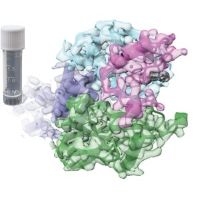Specification
| Description | Recombinant protein from the full-length sequence of homo sapiens 3-ketodihydrosphingosine reductase (KDSR) (NM_002035). |
| Organism | Homo sapiens (Human) |
| Expression Host | Human Cells |
| Tag Info | His or DYKDDDDK. Please contact us if you need further information or require specific designed tag. |
| Purity | Greater than 90% by SDS-PAGE gel |
| Uniprot ID | Q06136 |
| Entry Name | KDSR_HUMAN |
| Gene Names | KDSR FVT1 SDR35C1 |
| Alternative Gene Names | FVT1 SDR35C1 |
| Alternative Protein Names | 3-ketodihydrosphingosine reductase (KDS reductase) (EC 1.1.1.102) (3-dehydrosphinganine reductase) (Follicular variant translocation protein 1) (FVT-1) (Short chain dehydrogenase/reductase family 35C member 1) |
| Application | Antigens, Western, ELISA and other in vitro binding or in vivo functional assays, and protein-protein interaction studies; For research & development use only! |
| Buffer | Purified protein formulated in a sterile solution of PBS buffer, pH7.2, without any preservatives |
| Endotoxin | Endotoxin level is < 0.1 ng/µg of protein (<1EU /µg) |
| Length | 332 |
| Molecular Weight(Da) | 36187 |
| Protein Sequence | (The sequence of expressed protein may have some variation from the sequence shown below. Please contact us for the exact sequence.) MLLLAAAFLVAFVLLLYMVSPLISPKPLALPGAHVVVTGGSSGIGKCIAIECYKQGAFITLVARNEDKLLQAKKEIEMHSINDKQVVLCISVDVSQDYNQVENVIKQAQEKLGPVDMLVNCAGMAVSGKFEDLEVSTFERLMSINYLGSVYPSRAVITTMKERRVGRIVFVSSQAGQLGLFGFTAYSASKFAIRGLAEALQMEVKPYNVYITVAYPPDTDTPGFAEENRTKPLETRLISETTSVCKPEQVAKQIVKDAIQGNFNSSLGSDGYMLSALTCGMAPVTSITEGLQQVVTMGLFRTIALFYLGSFDSIVRRCMMQREKSENADKTA |
Background
| Function | FUNCTION: Catalyzes the reduction of 3-ketodihydrosphingosine (KDS) to dihydrosphingosine (DHS). {ECO:0000269|PubMed:28575652}. |
| Pathway | Lipid metabolism; sphingolipid metabolism. |
| Protein Families | Short-chain dehydrogenases/reductases (SDR) family |
| Tissue Specificity | Expressed in all tissues examined. Highest expression in placenta. High expression in lung, kidney, stomach and small intestine, low expression in heart, spleen and skeletal muscle. Weakly expressed in normal hematopoietic tissues. Higher expression in some T-cell malignancies and PHA-stimulated lymphocytes. |
QC Data
| Note | Please contact us for QC Data |
| Product Image (Reference Only) |  |

